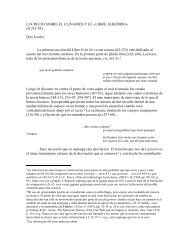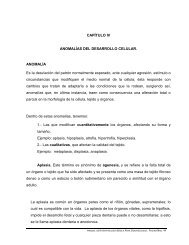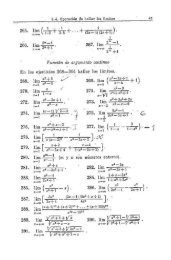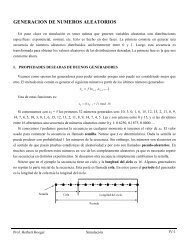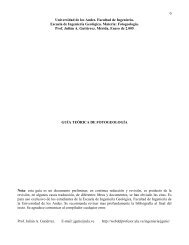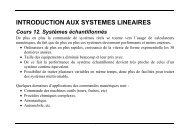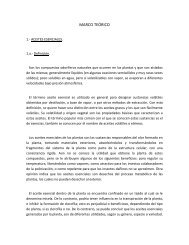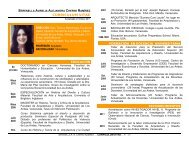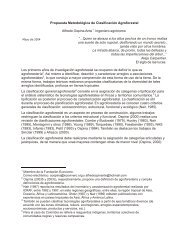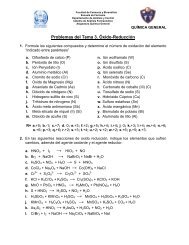Macrocyclic Ligands - Web del Profesor
Macrocyclic Ligands - Web del Profesor
Macrocyclic Ligands - Web del Profesor
Create successful ePaper yourself
Turn your PDF publications into a flip-book with our unique Google optimized e-Paper software.
their guests more strongly and are, in sequence, the spherands<br />
> cryptaspherands ≈ cryptands > hemispherands > crown<br />
ethers. 116<br />
A useful correlation of enthalpy–entropy considerations for<br />
complexation has been shown by Inoue, Liu, and Hakushi. 113<br />
The treatment reflects enthalpy–entropy relationships for<br />
given types of ligands. The general concept is that as the<br />
enthalpic contributions become strong, a higher level of<br />
organization is obtained, which will result in unfavorable<br />
entropy changes. For a given type of system with similar<br />
entropic versus enthalpic considerations, the T�S and �H<br />
values determined for a series of ligands should thus exhibit<br />
a linear relationship. This is found for the macrocyclic crown<br />
ethers, the cryptands, lariat ethers, and bis-crown ethers, as<br />
well as the acyclic polyethers known as podands. The slopes<br />
are all positive with high correlation coefficients. Gokel has<br />
suggested that these slopes can be used to assess the ligand<br />
flexibility: glymes and podands (0.86) > crown ethers (0.76)<br />
> cryptands (0.51). 119<br />
4.5.2 Lariat Ethers<br />
The lariat ethers (19) and (20) known to date consist<br />
of macrocycles with many different types of podand<br />
groups, and much of their complexation chemistry involves<br />
electrostatic binding of guests. Reviews of both structural and<br />
thermodynamic aspects of the lariat ethers can be found. 120–122<br />
The trends are noted to be relatively similar for both the<br />
carbon-pivot and nitrogen-pivot types of lariat ethers. Binding<br />
strengths and selectivities are dependent on ring size and in<br />
general increase as ligand size increases. Strong selectivities<br />
are noted for the potassium ion, as in the crown ethers.<br />
4.5.3 Spherands and Hemispherands<br />
The spherands (21) were specifically designed using the<br />
concept of ‘preorganization’ wherein the oxygen donors are<br />
arranged in an enforced spherical cavity. Totally prearranged<br />
(spherand) and partially arranged (hemispherand, (22))<br />
complexes are possible. 118 Due to the structural restraints<br />
imposed by the rigidly joined phenyl rings, the spherands are<br />
considered to be highly ‘preorganized’ binding sites. In these<br />
macrocycles the lone pair of electrons will always be pointed<br />
toward the center of the macrocyclic cavity.<br />
4.5.4 Calixarenes<br />
The calixarenes (23) are also highly preorganized<br />
molecules which are capable of forming different<br />
conformational isomers. The conformational flexibility is<br />
determined by the size of the ring, with the preferred conformation<br />
becoming more planar as the ring size increases. 37<br />
5 APPLICATIONS<br />
MACROCYCLIC LIGANDS 17<br />
As macrocyclic chemistry has developed, the variety and<br />
scope of the applications of these molecules have continued<br />
to multiply. This concluding section is an attempt to provide<br />
an overview of only three of the applications of synthetic<br />
macrocycles. A particularly insightful treatment can be<br />
found in the Nobel Lecture of Jean-Marie Lehn, 123 which<br />
describes the concept of supramolecular chemistry from<br />
simple recognition, to cation and anion receptors, multiple<br />
recognition, catalysis, transport, and molecular devices.<br />
5.1 Ion Transport<br />
Ion transport, especially cation transport, was one of the<br />
early focal points in macrocyclic chemistry, revolving primarily<br />
around the crown ethers and cryptands. Later efforts have<br />
been to provide switches to control the rates of cation transport.<br />
Two examples of the types of switches that have been<br />
developed include photo switches using cryptands, 124 and<br />
electrochemical switches using anthraquinone-derived lariat<br />
ethers. 125<br />
Related to transport capabilities is the use of synthetic<br />
macrocycles in analytical chemistry. Because of their selective<br />
complexation of a variety of cations, the crown ethers and<br />
related macrocycles have been wi<strong>del</strong>y used for separations<br />
and analyses. 126<br />
While transport efforts have largely involved metal<br />
cations, more recent developments have led to the use of<br />
macrocycles for transport of more complex molecules such as<br />
nucleosides. 127<br />
5.2 Catalysis<br />
Catalysis can be broken down into a number of areas,<br />
depending on the substrate and the catalytic reaction. One of<br />
the prime areas of the initial effort in catalysis has been small<br />
molecule activation, such as oxygen with a number of transition<br />
metal ion macrocycles 128,129 and carbon dioxide, the latter<br />
particularly with cobalt(I) and nickel(I) macrocycles. 130,131<br />
Once the polyammonium macrocycles were found to be able<br />
to recognize substrates other than metal ions, other catalysis<br />
applications evolved. For example, phosphoryl transfer catalysis<br />
with simple polyammonium macrocycles has become<br />
quite accessible. 132<br />
5.3 Magnetic Resonance Imaging<br />
<strong>Macrocyclic</strong> complexes have gained recognition in<br />
magnetic resonance imaging. 133,134 In order to be effective<br />
imaging agents, complexes must provide a significant<br />
enhancement in the proton relaxation rates of water,<br />
as well as be nontoxic, and thermodynamically stable.<br />
Hence, macrocyclic ligands with pendant carboxylates, such



